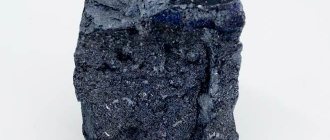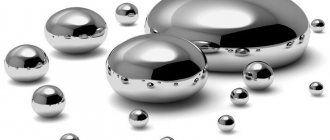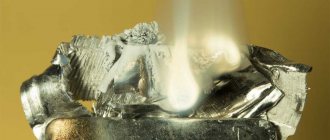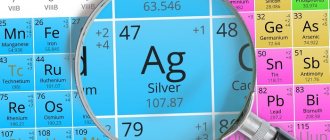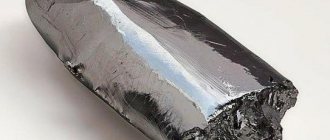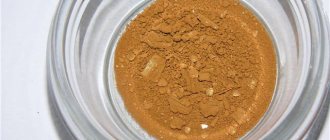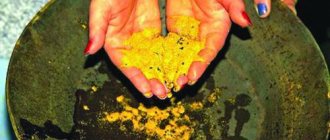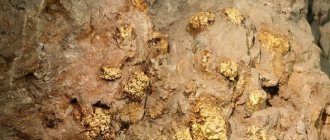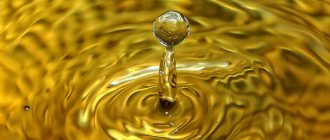Mercury
- mineral, natural metallic mercury. A transition metal, at room temperature it is a heavy, silvery-white liquid, the vapors of which are extremely toxic. Mercury is one of two chemical elements (and the only metal), the simple substances of which, under normal conditions, are in a liquid aggregate state (the second such element is bromine). Sometimes it contains an admixture of silver and gold.
- Structure
- Properties
- Reserves and production
- Origin
- Application
- Classification
- Physical properties
- Optical properties
- Crystallographic properties
See also:
Ice
– structure and physical properties
PROPERTIES
The color is pewter white. The shine is strong metallic. Boiling point 357 °C. The only liquid mineral at ordinary temperatures. It hardens, acquiring a crystalline state at −38°C. Density 13.55. Easily evaporates on fire to form toxic fumes. In ancient times, inhalation of these vapors was the only available means of treating syphilis (according to the principle: if the patient does not die, he will recover. It is diamagnetic.
Receipt
R. receive Ch. arr. firing cinnabar HgS at 700–800 °C. Reduced R. is removed from the reaction zone with exhaust gases, purified from suspended particles in electric precipitators, and collected in condensers. R. yield is more than 80%. To obtain technical product R. is filtered through porous partitions, ceramic. filters, cloth, suede are successively washed with alkali solutions, nitric acid, Hg(NO3)2 solutions and distilled. Hydrometallurgical R. is extracted by treating cinnabar with aqueous alkaline solutions of sodium sulfide or polysulfide. The resulting solutions of R. thiosalts are subjected to electrolysis. To obtain especially pure R., a four-stage electrochemical process is used. refining in electrolyzers with mercury electrodes.
The volume of R. use is approx. 4000 t/year.
RESERVES AND PRODUCTION
Mercury is a relatively rare element in the earth's crust with an average concentration of 83 mg/t. However, due to the fact that mercury weakly binds chemically to the most common elements in the earth's crust, mercury ores can be very concentrated compared to ordinary rocks. The most mercury-rich ores contain up to 2.5% mercury. The main form of mercury in nature is dispersed, and only 0.02% of it is contained in deposits. The mercury content in different types of igneous rocks is close to each other (about 100 mg/t). Among sedimentary rocks, the maximum concentrations of mercury are found in clay shales (up to 200 mg/t). The mercury content in the waters of the World Ocean is 0.1 µg/l. The most important geochemical feature of mercury is that among other chalcophile elements it has the highest ionization potential. This determines such properties of mercury as the ability to be reduced to an atomic form (native mercury), significant chemical resistance to oxygen and acids.
One of the world's largest mercury deposits is located in Spain (Almaden). There are known deposits of mercury in the Caucasus (Dagestan, Armenia), Tajikistan, Slovenia, Kyrgyzstan (Khaidarkan - Aidarken) Ukraine (Gorlovka, Nikitovsky mercury plant).
There are 23 mercury deposits in Russia, industrial reserves amount to 15.6 thousand tons (as of 2002), of which the largest have been explored in Chukotka - West Palyanskoye and Tamvatneyskoye.
Mercury is obtained by roasting cinnabar (mercury(II) sulfide) or by the metallothermic method. Mercury vapor is condensed and collected. This method was used by ancient alchemists.
Prevalence in nature
The content of phosphorus in the earth's crust is 7.0·10–6% by mass, in the sea. water 0.03 mg/m3, in the atmosphere 2·10–3 mg/m3. R. is classified as trace elements (only 0.02% of all R. is found in concentrated form in deposits); occurs in nature in a free state (native mercury). Forms more than 30 minerals. Basic ore mineral – cinnabar HgS. R. minerals in the form of isomorphic impurities are found in quartz, chalcedony, carbonates, micas, and lead-zinc ores. A large amount of R is involved in the metabolic processes of the hydrosphere, lithosphere, and atmosphere. See also Mercury ores.
ORIGIN
Mercury is present in most sulfide minerals. Its especially high contents (up to thousandths and hundredths of a percent) are found in fahlores, stibnites, sphalerites and realgars. The proximity of the ionic radii of divalent mercury and calcium, monovalent mercury and barium determines their isomorphism in fluorites and barites. In cinnabar and metacinnabarite, sulfur is sometimes replaced by selenium or tellurium; The selenium content is often hundredths and tenths of a percent. Extremely rare mercury selenides are known - timanite (HgSe) and onofrite (a mixture of timanite and sphalerite).
Biological role
R. is highly toxic to all forms of life. Vapors and compounds of phosphorus are extremely toxic, accumulate in the body, are easily absorbed by lung tissue, enter the blood, and are subjected to enzymatic oxidation to phosphorus ions, which form compounds with protein molecules and enzymes, disrupt metabolism, and affect the nervous system. MPC of R. in the air of the working area is 0.01 mg/m3, in atmospheric air 0.0003 mg/m3, in water of reservoirs 0.0005 mg/dm3, in soil 2.1 mg/kg. When working with R., complete sealing of the equipment is necessary. Steel cylinders are used to store R. Accidentally spilled R. must be collected with a copper plate, then the surface must be treated with a solution of FeCl3 (demercurization).
Natural sources of environmental pollution are evaporation from the entire land surface, sublimation from compounds located deep in the earth’s crust, volcanic. activity; anthropogenic sources – metallurgy, organic combustion. fuels, chlorine and soda production, household (garbage burning, waste water, etc.), etc. Ecological. the consequences manifest themselves primarily in the aquatic environment - the vital activity of unicellular marine organisms and fish is suppressed, photosynthesis is disrupted, nitrates, phosphates, ammonium compounds, etc. are assimilated.
APPLICATION
Mercury is used as a working fluid in mercury thermometers (especially high-precision ones), since it has a fairly wide range in which it is in the liquid state, its coefficient of thermal expansion is almost independent of temperature and has a relatively low heat capacity. An alloy of mercury and thallium is used for low-temperature thermometers. Fluorescent lamps are filled with mercury vapor because the vapor glows in a glow discharge. The emission spectrum of mercury vapor contains a lot of ultraviolet light, and in order to convert it into visible light, the glass of fluorescent lamps is coated from the inside with a phosphor. Without a phosphor, mercury lamps are a source of hard ultraviolet light (254 nm), which is what they are used for. Such lamps are made of quartz glass, which transmits ultraviolet light, which is why they are called quartz. Mercury and its alloys are used in sealed switches that turn on at a certain position. Mercury is used in position sensors.
Mercury(I) iodide is used as a semiconductor radiation detector. Mercury(II) fulminate (“mercury fulminate”) has long been used as an initiating explosive (Detonators). Mercury(I) bromide is used in the thermochemical decomposition of water into hydrogen and oxygen (atomic hydrogen energy). The use of mercury in alloys with cesium as a highly efficient working fluid in ion engines is promising. Until the mid-20th century, mercury was widely used in barometers, pressure gauges and sphygmomanometers (hence the tradition of measuring pressure in millimeters of mercury).
Mercury compounds were used in the hat industry to make felt.
Mercury – Hg
| Molecular weight | 200.59 g/mol |
| origin of name | from the Latin alchemical name of this element hydrargyrum (from ancient Greek ὕδωρ “water” and ἄργυρος “silver”) |
| IMA status | valid, first described before 1959 (before IMA) |
Content
- 1 History 1.1 Origin of the name
- 2.1 Deposits
- 7.1 Characteristic oxidation states
- 8.1 Medicine
- 9.1 Hygienic regulation of mercury concentrations
PHYSICAL PROPERTIES
| Mineral color | pewter white |
| Stroke color | cannot be taken |
| Transparency | opaque |
| Shine | metal |
| Cleavage | No |
| Hardness (Mohs scale) | cannot be measured |
| Kink | No |
| Density (measured) | 13.596 g/cm3 |
| Radioactivity (GRapi) | 0 |
| Magnetism | diamagnetic |
Story
The astronomical symbol of the planet Mercury
Mercury has been known since ancient times. It was often found in its native form (liquid drops on rocks), but more often it was obtained by firing natural cinnabar. The ancient Greeks and Romans used mercury to purify gold (amalgamation) and knew about the toxicity of mercury itself and its compounds, in particular sublimate. For many centuries, alchemists considered mercury to be the main component of all metals and believed that if liquid mercury was restored to hardness with the help of sulfur or arsenic, gold would be obtained. The isolation of mercury in its pure form was described by the Swedish chemist Georg Brandt in 1735. To represent the element, both alchemists and today use the symbol of the planet Mercury. But the belonging of mercury to metals was proven only by the works of Lomonosov and Brown, who in December 1759 were able to freeze mercury and establish its metallic properties in the solid state: malleability, electrical conductivity, etc.
origin of name
The Russian name for mercury comes from praslav. *rьtǫtь, associated with lit. rìsti "to roll". The symbol Hg is borrowed from the Latin alchemical name for this element, hydrargyrum
(from ancient Greek ὕδωρ “water” and ἄργυρος “silver”).
What is the danger of mercury
Despite the fact that mercury looks like something integral, it emits a lot of vapors, which, when entering the body, lead not only to lung damage, but also to other often irreversible changes. It is especially dangerous at the stage of intrauterine development.
When ingested, mercury has toxic effects on the digestive, immune and nervous systems. In addition, the skin, kidneys, lungs and even eyes are affected. It’s no wonder that the World Health Organization (WHO) lists mercury as one of the top ten substances that pose the greatest threat to public health.
It's better not to do that.
Mercury is most dangerous in the form of vapor or solution. When it gets into water, it leads to the death of microorganisms and remains in it forever in the form of that same solution. As a result, it can get into the water supply system and harm an entire settlement. Moreover, even a minimal amount of mercury is enough to affect a person.
There are also two types of mercury compounds - organic and inorganic. The former (for example, dimethylmercury) are much more dangerous, as they interact more effectively with the body's systems.
How many tables of chemical elements are there really?
Liquid silver in our home
Almost every home has a mercury thermometer, and it is very easy to break it. Mercury will end up on the floor, creating a health hazard.
How to properly collect mercury balls:
- Mercury easily “sticks” to tin foil.
- If there is nitric acid in the house, soak a copper wire in it and collect mercury balls in a container (preferably glass).
- Try to collect the balls with a syringe without a needle.
- Small particles can be collected with tape.
- Treat the spill area with a solution of potassium permanganate or bleach.
Do not collect spilled metal with a broom or vacuum cleaner.
Informative: if you bought a thermometer and it contains red liquid, do not think that it is the legendary red mercury. This is just an alcohol thermometer, not a mercury thermometer.
Properties of mercury (table): temperature, density, pressure, etc.:
Detailed information on the website ChemicalStudy.ru
| 100 | General information | |
| 101 | Name | Mercury |
| 102 | Former name | |
| 103 | Latin name | Hydrargyrum |
| 104 | English name | Mercury |
| 105 | Symbol | Hg |
| 106 | Atomic number (number in table) | 80 |
| 107 | Type | Metal |
| 108 | Group | Transitional, heavy, non-ferrous metal |
| 109 | Open | Known since ancient times |
| 110 | Opening year | before 1500 BC e. |
| 111 | Appearance, etc. | A heavy liquid metal of a silvery-white color, volatile even at room temperature. Colorless in gaseous state |
| 112 | Origin | Natural material |
| 113 | Modifications | |
| 114 | Allotropic modifications | 3 allotropic modifications: – α-mercury, – β-mercury, – γ-mercury |
| 115 | Temperature and other conditions for the transition of allotropic modifications into each other | |
| 116 | Bose-Einstein condensate | |
| 117 | 2D materials | |
| 118 | Content in the atmosphere and air (by mass) | 0 % |
| 119 | Content in the earth's crust (by mass) | 6,7·10-6 % |
| 120 | Content in seas and oceans (by mass) | 5,0·10-9 % |
| 121 | Content in the Universe and space (by mass) | 1,0·10-7 % |
| 122 | Abundance in the Sun (by mass) | 2,0·10-6 % |
| 123 | Content in meteorites (by mass) | 0,000025 % |
| 124 | Content in the human body (by weight) | |
| 200 | Properties of the atom | |
| 201 | Atomic mass (molar mass) | 200.592(3) a. e.m. (g/mol) |
| 202 | Electronic configuration | 1s2 2s2 2p6 3s2 3p6 3d10 4s2 4p6 4d10 4f14 5s2 5p6 5d10 6s2 |
| 203 | Electronic shell | K2 L8 M18 N32 O18 P2 Q0 R0 |
| 204 | Atomic radius (calculated) | 171 pm |
| 205 | Empirical atomic radius* | 150 pm |
| 206 | Covalent radius* | 136 pm |
| 207 | Ion radius (crystalline) | Hg+ 133 (6) pm, Hg2+ 83 (2) pm, 110 (4) pm, 116 (6) pm, 128 (8) pm (in parentheses the coordination number is indicated - a characteristic that determines the number of nearest particles (ions or atoms) in a molecule or crystal) |
| 208 | Van der Waals radius | 155 pm |
| 209 | Electrons, Protons, Neutrons | 80 electrons, 80 protons, 121 neutrons |
| 210 | Family (block) | d-family element |
| 211 | Period in the periodic table | 6 |
| 212 | Group on the periodic table | 12th group (according to the old classification - a secondary subgroup of the 2nd group) |
| 213 | Emission spectrum | |
| 300 | Chemical properties | |
| 301 | Oxidation states | -2, +1, +2 |
| 302 | Valence | I, II |
| 303 | Electronegativity | 2.0 (Pauling scale) |
| 304 | Ionization energy (first electron) | 1007.07 kJ/mol (10.437504(6) eV) |
| 305 | Electrode potential | Hg22+ + 2e– → 2Hg, Eo = +0.788 V, Hg2+ + 2e– → Hg, Eo = +0.850 V, 2Hg2+ + 2e– → Hg22+, Eo = +0.920 V |
| 306 | Electron affinity energy of an atom | -48(20) kJ/mol (-0.5(2) eV) – presumably |
| 400 | Physical properties | |
| 401 | Density* | 14.193 (at -38.9 °C and other standard conditions, state of matter – solid), 13.5954 g/cm3 (at 0 °C and other standard conditions, the state of matter is liquid), 13.534 g/cm3 (at 20 °C and other standard conditions , state of matter – liquid), 12.8806 g/cm3 (at 300 °C and other standard conditions , state of matter – liquid) |
| 402 | Melting temperature* | -38.8290 °C (234.3210 K, -37.8922 °F) |
| 403 | Boiling temperature* | 356.73 °C (629.88 K, 674.11 °F) |
| 404 | Sublimation temperature | |
| 405 | Decomposition temperature | |
| 406 | Self-ignition temperature of a gas-air mixture | |
| 407 | Specific heat of fusion (enthalpy of fusion ΔHpl)* | 2.29 kJ/mol |
| 408 | Specific heat of evaporation (enthalpy of boiling ΔHboiling)* | 59.11 kJ/mol |
| 409 | Specific heat capacity at constant pressure | 0.141 J/g K (at -40 °C), 0.1405 J/g K (at 0 °C), 0.1395 J/g K (at 25 °C), 0.1355 J/g ·K (at 140 °C) |
| 410 | Molar heat capacity* | 27.983 J/(K mol) |
| 411 | Molar volume | 14.821 cm³/mol |
| 412 | Thermal conductivity | 8.3 W/(mK) (at standard conditions ), 8.3 W/(mK) (at 300 K) |
| 500 | Crystal cell | |
| 511 | Crystal grid #1 | α-mercury |
| 512 | Lattice structure | Rhombohedral (trigonal) |
| 513 | Lattice parameters | a = 2.990 Å, α = 70.317° |
| 514 | c/a ratio | |
| 515 | Debye temperature | 100 K |
| 516 | Name of space symmetry group | R_ 3m |
| 517 | Symmetry space group number | 166 |
| 900 | additional information | |
| 901 | CAS number | 7439-97-6 |
Note:
205* The empirical radius of the mercury atom according to [1] and [3] is 151 pm and 157 pm, respectively.
206* The covalent radius of mercury according to [1] and [3] is 132±5 pm and 149 pm, respectively.
401* The density of mercury according to [3] and [4] is 13.546 g/cm3 (at 20 °C and other standard conditions , the state of the substance is liquid) and 13.5461 g/cm3 (at 20 °C and other standard conditions , the state substances – liquid) respectively.
402* The melting point of mercury according to [3] and [4] is -38.83 °C (234.32 K, -37.89 °F) and -38.89 °C (234.26 K, -38 °F ) respectively.
403* The boiling point of mercury according to [4] is 356.66 °C (629.81 K, 673.99 °F).
407* The specific heat of fusion (enthalpy of fusion ΔHmel) of mercury according to [3] is 2.295 kJ/mol.
408* The specific heat of evaporation (enthalpy of boiling ΔHboiling) of mercury according to [3] and [4] is 58.5 kJ/mol and 59.22 kJ/mol, respectively.
410* The molar heat capacity of mercury according to [3] is 27.98 J/(K mol).
Crystal lattice of mercury:
| 500 | Crystal cell | |
| 511 | Crystal grid #1 | α-mercury |
| 512 | Lattice structure | Rhombohedral (trigonal) |
| 513 | Lattice parameters | a = 2.990 Å, α = 70.317° |
| 514 | c/a ratio | |
| 515 | Debye temperature | 100 K |
| 516 | Name of space symmetry group | R_ 3m |
| 517 | Symmetry space group number | 166 |
How does a mercury thermometer work?
If the liquid in the tube is cold, then its molecules are located in close proximity to each other. In this case, the liquid does not take up much space and almost all of it is in a tiny flask at the end of the thermometer. But if you leave the thermometer in direct sunlight, insert it under your armpit or squeeze it in your palms, the liquid inside the thermometer will heat up, and its molecules will begin to actively move and repel each other. They no longer have enough space inside the cone, and they begin to rise up the tube. The warmer the environment, the higher the liquid rises. Despite the accuracy of mercury thermometers, they are gradually being replaced by electronic ones.
Share link
